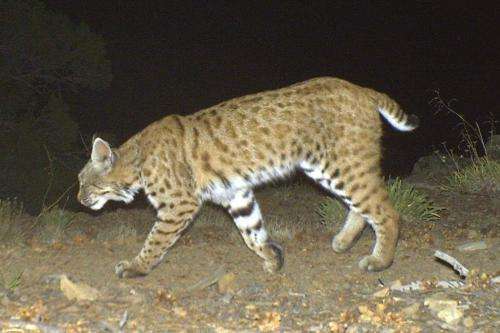Bobcats more likely to get diseases from urban areas, scientists say

(Phys.org)—Bobcats are more likely to pick up parasites such as Giardia when they're closer to urban areas with a heavier human impact on the environment, according to a new study by Colorado State University wildlife and veterinary scientists.
The paper appears in the September 2012 issue of the Journal of Clinical Microbiology. The research was funded by the National Science Foundation Ecology of Infectious Disease Program.
Researchers collected fecal samples in Ventura County, Calif., and along Colorado's Front Range and Western Slope, and tested them for Toxoplasma gondii, Giardia duodenalis and Cryptosporidium spp.– all parasites that cause health issues in people and wildlife, with the latter two causing diarrhea and other gastrointestinal problems.
Findings revealed that bobcats near urban areas of Boulder, Colo., and Los Angeles were more likely to have those parasites than bobcats living in more rural areas in Colorado.
Faculty and students collaborating on the project represented Warner College of Natural Resources and the College of Veterinary Medicine and Biomedical Sciences at Colorado State.
"We found support for our hypothesis that bobcats become exposed to and shed zoonotic parasites in fecal material around human-occupied landscapes," said Kevin Crooks, professor in the Department of Fish, Wildlife and Conservation Biology. Among his co-authors were Dr. Sue VandeWoude, professor in the Department of Microbiology, Immunology and Pathology, and Dr. Mike Lappin from the Department of Clinical Sciences.
"Bobcats seem to have acquired Giardia from humans rather than the other way around – they were probably exposed to the water supply around cities," VandeWoude said. "Giardia can infect people and may cause gastrointestinal disease."
The study also found a high incidence of bobcat exposure to the parasite Toxoplasma gondii, but did not find evidence animals were shedding the disease. This parasite can infect humans and causes mild to minimal disease in healthy people, but can cause complications for infants and people with a compromised immune system. Cats only spread toxoplasma in their feces for a few weeks following infection with the parasite. This study suggests the lifecycle of the parasite in bobcats is similar to domestic cats.
There was no evidence that the bobcats shedding these parasites were actually sick, researchers said.
The paper is a follow-up by the same scientists who released a study in February showing that domestic cats, bobcats and pumas that live in the same area share diseases – and may bring them into family homes. The study provided evidence that domestic cats and wild cats that share the same outdoor areas in urban environments can also share diseases such as bartonellosis and toxoplasmosis, both of which can be spread from cats to people.
The earlier study looked at urban areas of California and Colorado and shows these diseases can spread through contact with shared habitat and how the diseases can be clustered due to urban development and major freeways that restrict animal movement.
Both studies involved collaboration with field biologists, federal and state agencies, animal shelters and other institutions.
Journal information: Journal of Clinical Microbiology
Provided by Colorado State University


















